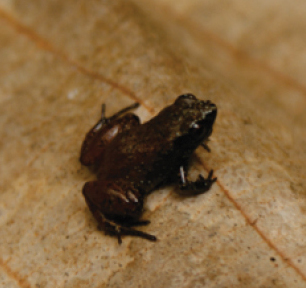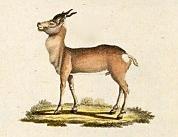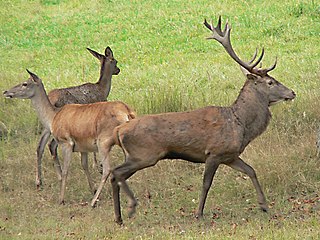
Onchocerciasis, also known as river blindness, is a disease caused by infection with the parasitic worm Onchocerca volvulus. Symptoms include severe itching, bumps under the skin, and blindness. It is the second-most common cause of blindness due to infection, after trachoma.

Filariasis is a parasitic disease caused by an infection with roundworms of the Filarioidea type. These are spread by blood-feeding insects such as black flies and mosquitoes. They belong to the group of diseases called helminthiases.

The antilopines are even-toed ungulates belonging to the subfamily Antilopinae of the family Bovidae. The members of tribe Antilopini are often referred to as true antelopes, and include the gazelles, blackbucks, springboks, gerenuks, dibatags, and Central Asian gazelles. True antelopes occur in much of Africa and Asia, with the highest concentration of species occurring in East Africa in Sudan, Eritrea, Ethiopia, Somalia, Kenya, and Tanzania. The saiga inhabits Central and Western Asia, mostly in regions from the Tibetan Plateau and north of the Indian Subcontinent. The dwarf antelope species of tribe Neotragini live entirely in sub-Saharan Africa.

Onchocerca volvulus is a filarial (arthropod-borne) nematode (roundworm) that causes onchocerciasis, and is the second-leading cause of blindness due to infection worldwide after trachoma. It is one of the 20 neglected tropical diseases listed by the World Health Organization, with elimination from certain countries expected by 2025.

The Mongolian gazelle, or dzeren, is a medium-sized antelope native to the semiarid Central Asian steppes of Mongolia, southern Siberia and northern China. The name dzeren is the Russian spelling and pronunciation of the Mongolian word zeer, or the Buryat zeeren.
Mansonelliasis is the condition of infection by the nematode Mansonella. The disease exists in Africa and tropical Americas, spread by biting midges or blackflies. It is usually asymptomatic.

Adelophryne gutturosa is a species of frogs in the family Eleutherodactylidae. It is found on the Guiana Shield from eastern Venezuela through Guyana to French Guiana and adjacent Brazil (Amapá), possibly extending to Suriname. Its type locality is Mount Roraima. Its local Spanish name is ranita guturosa.
Coptodon gutturosa is a critically endangered species of fish in the cichlid family. It is endemic to Lake Bermin in Cameroon. It is threatened by pollution and sedimentation from human activities, and potentially also by large emissions of carbon dioxide (CO2) from the lake's bottom (compare Lake Nyos), although Bermin is too shallow to contain very high amounts of this gas.

Onchocerca is a genus of parasitic roundworm. It contains one human parasite – Onchocerca volvulus – which is responsible for the neglected disease Onchocerciasis, also known as "river blindness" because the infected humans tend to live near rivers where host black flies live. Over 40 million people are infected in Africa, Central America, and South America. Other species affect cattle, horses, etc.

Procapra is a genus of Asian gazelles, including three living species:
Elaeophora bohmi is a nematode parasite found in various arteries of the horse. The adult males are 44-55 mm long and 95 µm wide, while adult females can be over 12 cm long and 210 µm wide. Microfilariae are not sheathed, and measure 300-330 µm long and 6-7 µm wide. The life cycle and clinical symptoms of infestation by E. bohmi have not been described.

The Onchocercidae are a family of nematodes in the superfamily Filarioidea. This family includes some of the most devastating human parasitic diseases, such as lymphatic filariasis, onchocerciasis, loiasis, and other filariases.
Mansonella streptocerca,, is a filarial (arthropod-borne) nematode (roundworm) causing the disease streptocerciasis. It is a common parasite in the skin of humans in the rain forests of Africa, where it is thought to be a parasite of chimpanzees, as well.
Lake Bermin is a small lake in the volcanic chain in the Southwest Region of Cameroon. It is a volcanic lake with a diameter of about 700 m (2,300 ft) and a crater rim that rises to a height of about 46 m (150 ft). This highly isolated lake is roughly circular in shape, lacks an inflow, but has an outflow into the Cross River system.

Onchocerca tubingensis is the name of a nematode. It was discovered in 1974 and published by O. Bain und H. Schulz-Key in Tropenmedizin und Parasitologie and named after Tübingen. Red deer are the host of this parasite. The adult worms of Onchocerca tubingensis are found in subcutaneous nodules on the caudal part of the back, while the microfilariae are distributed on the ventral part of the body with maximum densities in the region of the sternum and with lower densities on the inner sides of the hindlegs. The infection rates of 94 red deer investigated in southern Germany during 1907–1974 were 23%.

Simulium yahense is a species of black flies found in West African rain forests. Their larval stages are found in "smaller, more shaded, cooler breeding waters." One particular group, now eradicated, was found only on the island of Bioko, and was an extremely effective vector for the parasitic worm Onchocerca volvulus that causes onchocerciasis, or "river blindness".

Coptodon is a genus of cichlids native to fresh, brackish and coastal marine waters in Africa with C. zillii also found in the Middle East. It is the only genus in the tribe Coptodonini. Formerly included in Tilapia, this genus and tribe was separated in 2013. Despite the change in genus, Coptodon spp. are still referred to by the common name tilapia. Several species are important in local fisheries and a few are aquacultured.

Adelophryne patamona is a species of frog in the family Eleutherodactylidae. It is endemic to the Pacaraima Mountains of southwestern Guyana, although it is likely to also occur in the adjacent Roraima state of Brazil. It is most closely related to A. gutturosa.
Onchocerca lupi is a nematode that causes ocular onchocerciasis, an eye disease, in canines and felines. The parasite was first described in 1967 in a wolf from Georgia. The other Onchocerca spp., O. volvulus, is a human parasite that causes ocular onchocerciasis in human and affects 37 million people globally.
Onchocerca gibsoni is a species of nematodes belonging to the family Onchocercidae.










